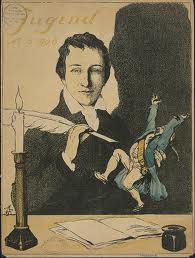Heinrich Heine
Date: 1836
Region: Europe
Subject: Political/Economic/Social Opinion
Medium: Literature
Artist: Heinrich Heine (1797 - 1856)
Confronting Bodies: The Bundestag (the governing body of the German Confederation) and the Vatican
Date of Action: 1836
Location: Prussia
Description of Artwork: Heine wrote poems set to music (lieder). Many of these mock social and political issues. Sometimes he used religion to illustrate social concerns using Jesus Christ to convey revolutionary messages. His writing satirized political individuals as well as concepts like bourgeois materialism. He never fought censors, but instead often developed his own specialized style of writing in order to avoid their notice.
The Incident: Heine began to see his published work censored in 1820, but due to loopholes concerning censorship procedures, was often able to avoid it. In 1835, however, the Prussian censorship laws were changed by the Bundestag. Now, not only could Heine not avoid having his work edited, but Prussia had even banned his unpublished materials. In 1836 he complained to the Federal Assembly that their actions were unjust and that he had a right to his own intellectual property. This complaint went unheard.
At the same time, papal authorities put his works on trial and judged them in secret. In late 1836, the pope announced that many of Heine's works were now banned, forbidding all faithful Catholics to read his texts. No reason was given for this ban other than the fact that it was God's word, so reasons were unneeded. It is now understood that the Vatican was also influenced by an Austrian chancellor, Clemens Metternich, who brought Hein to their attention because of his own fear of Heine's social messages and popularity with the public.
Results of Incident: Heine left Prussia voluntarily, but in 1840, after seeing poems he published in Paris, the government had him officially exiled and forbidden to return. The ban from the Vatican was lifted in 1867, over ten years after Heine died in 1856, but his works continued to be controversial in Germany. In 1933, his writing was targeted to be burned by the Nazis and later his works sparked debates between East and West Germany where he was misinterpreted by both sides.
Source: Censorship: A World Encyclopedia. Ed. Derek Jones. Chicago; London: Fitzroy Dearborn, 2001.
